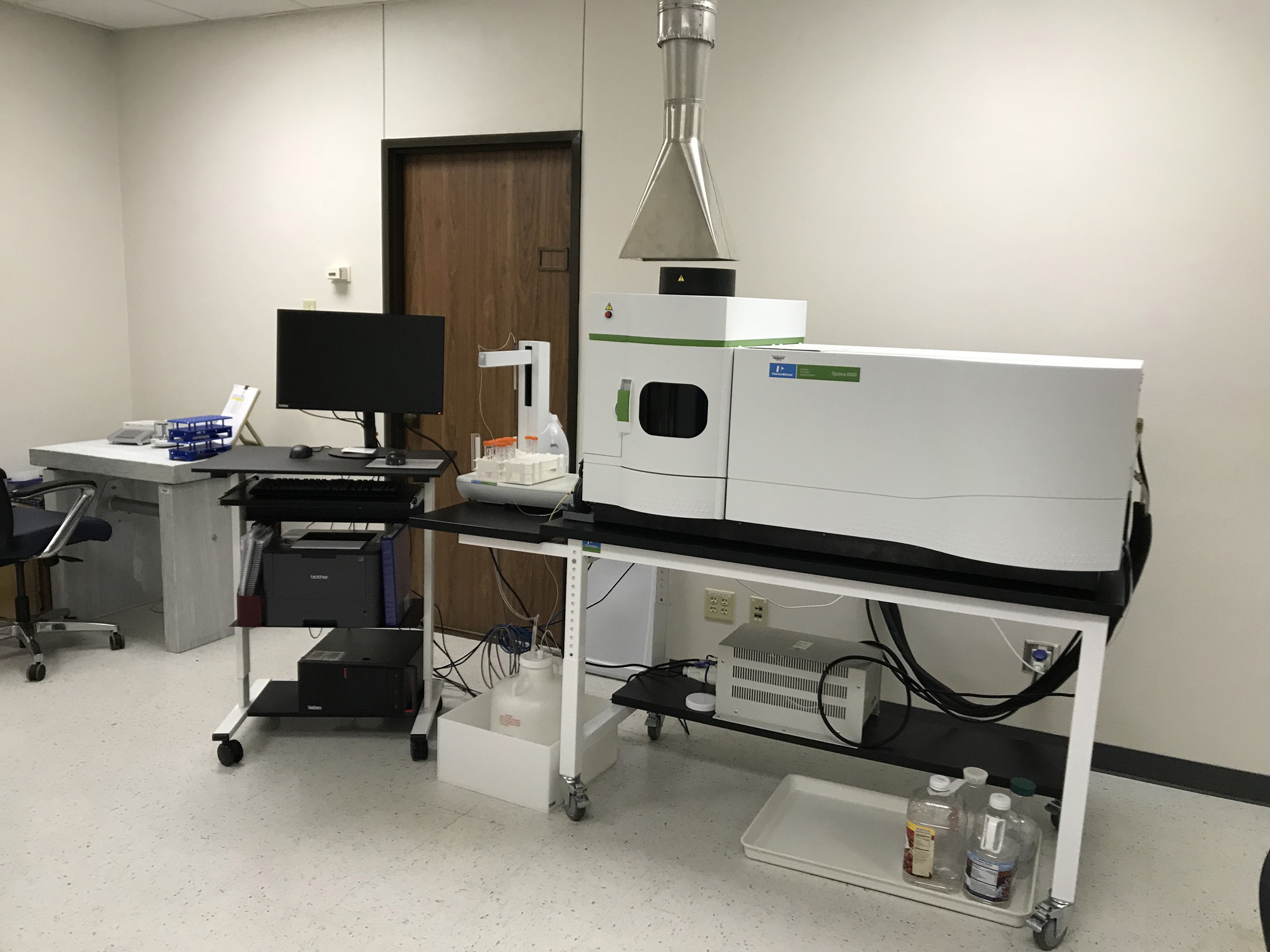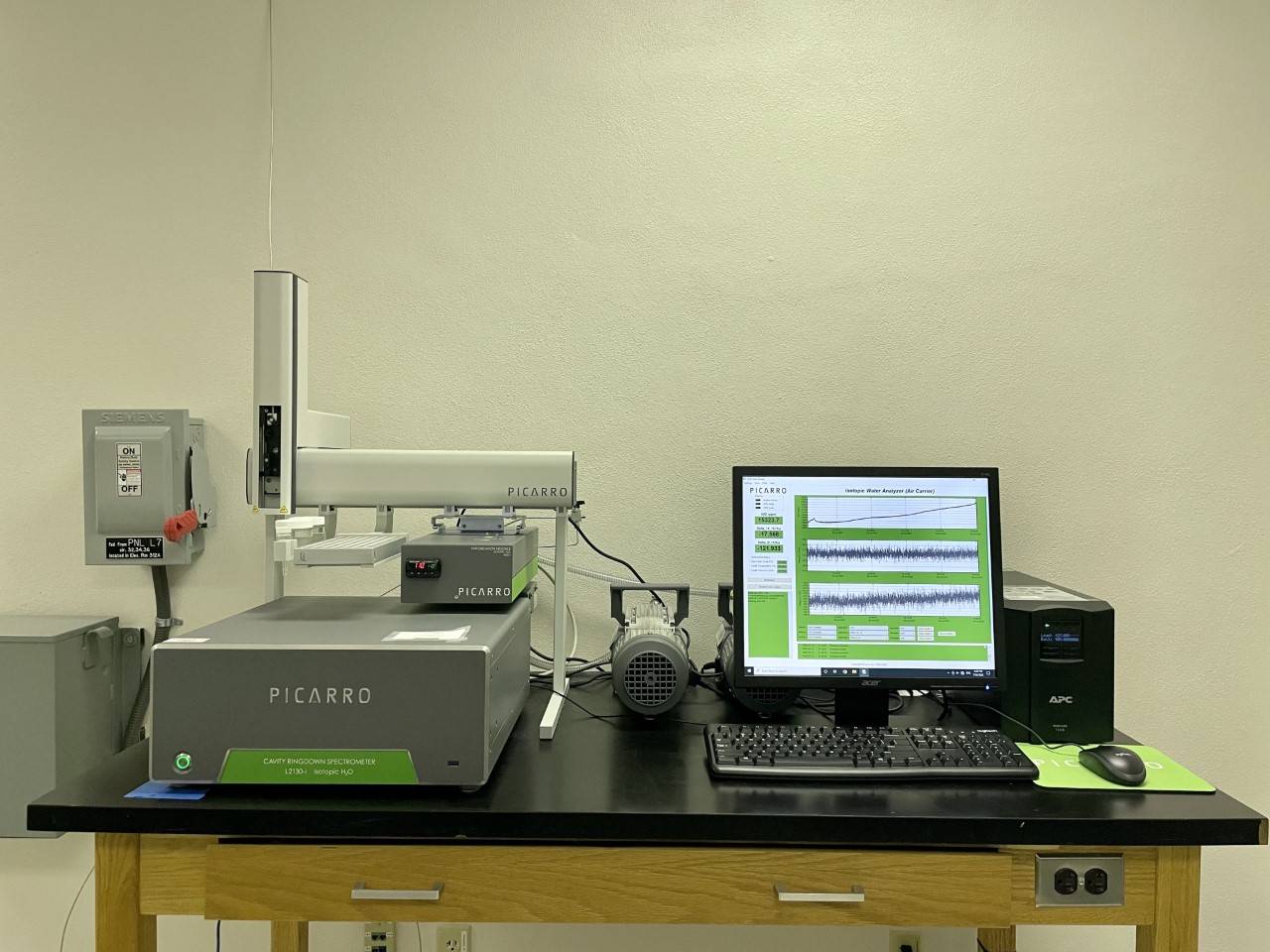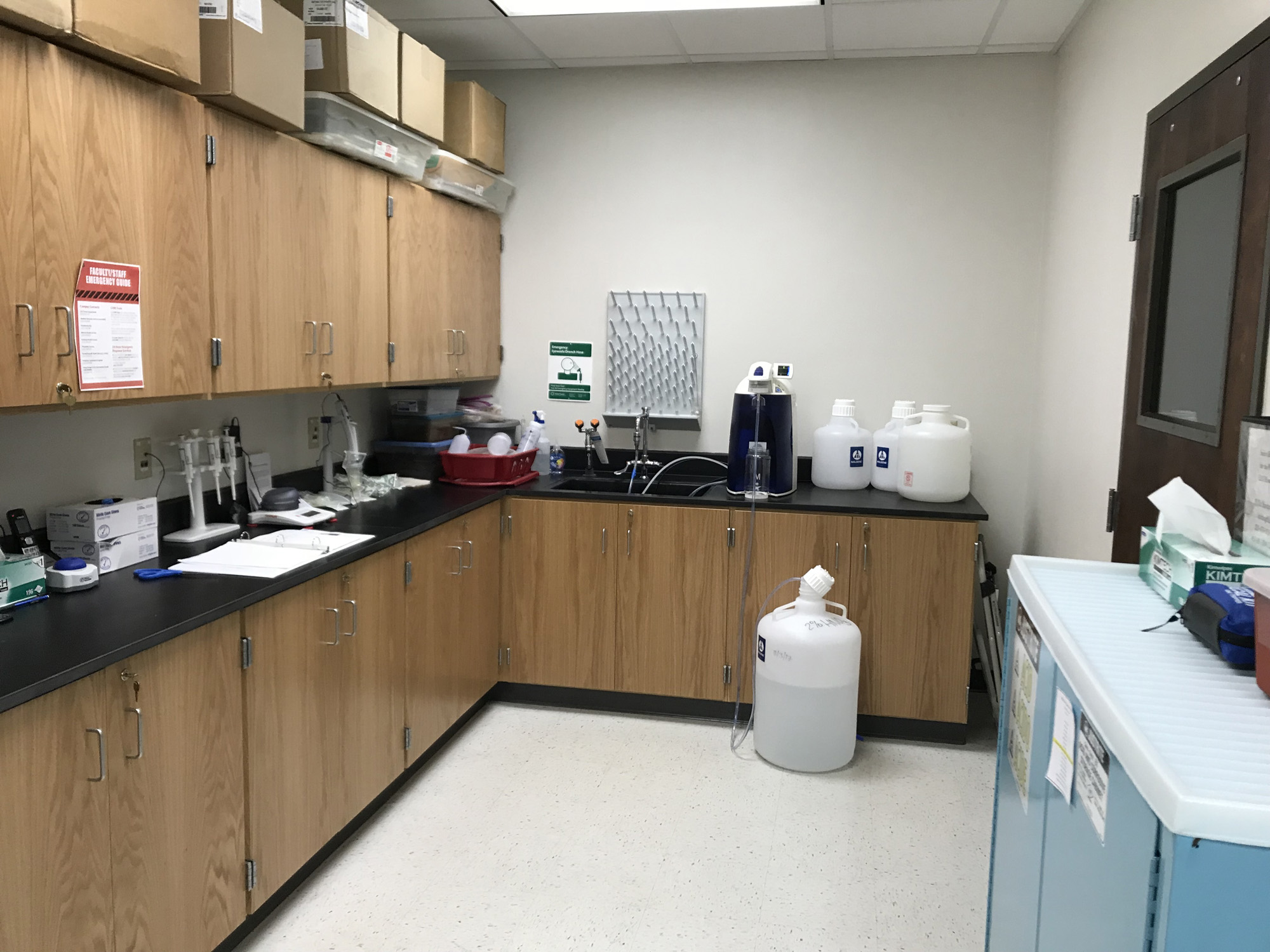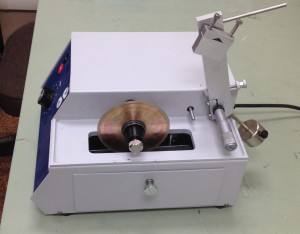Facilities & Equipment
The PAST Laboratory is the newest facility in the Geography and Anthropology Department with 2600 square feet of laboratory and office space containing all the necessary equipment to prepare carbonate samples for geochemical analysis and to collaborate on paleoclimate research.
ICP-OES

Perkin Elmer 8300 ICP-OES in instrument room
The PAST lab houses a Perkin Elmer 8300 Inductive Coupled Plasma Optical Emission Spectrophotometer (ICP-OES) for trace elemental analysis of Sr/Ca, Mg/Ca, and Ba/Ca in carbonates (corals, shells, foraminifera, and speleothems). The 8300 has radial and axial views of the plasma and simultaneous readings of a wide range of elemental wavelengths for concentrations in the part per million (ppm) range. We can analyze up to 200 samples in 24 hours including references. Samples are dissolved in 2% nitric acid and weighed on the microbalance to achieve a 20 ppm Ca concentration for ICP-OES analysis following the method of Schrag 1999. The relative standard deviation (RSD) of our in-house gravimetric standard (IGS) for Sr/Ca is typically 0.15% or better, 0.16% for our in-house coral reference, Porites lutea (PL), and 0.18% for the international coral standard JCp-1. Accuracies for Sr/Ca are 0.09% for PL and -0.15% for JCp-1. Barium in carbonates is a relatively new analyte for ICP-OES analysis and we are achieving accuracies and precisions similar to ICP-MS in coral and shell samples (IGS = 1.49%, PL =4.67%, and 1.25% accuracy for JCp-1). If you are interested in using the ICP-OES for your project, please contact Kristine DeLong at kdelong@lsu.edu.
Isotopic Water Analyzer

Picarro L2130-i Isotopic Water Analyzer
The PAST Laboratory houses a Picarro L2130-i Isotopic Water Analyzer for high-precision measurements of oxygen and hydrogen isotope ratios (δ18O and δD). The L2130-i utilizes Cavity Ring-Down Spectroscopy (CRDS) to convert spectroscopic measurements into gas concentration. Currently, we are analyzing freshwater but have plans to expand to saltwater. If you are interested in using the L2130-i Isotopic Water Analyzer for your project, please contact Kristine DeLong at kdelong@lsu.edu.
Wet Lab

Wet lab in PAST lab for preparing aqueous samples.
The PAST Laboratory has facilities for aqueous sample preparation including a Milli-Q water filtration system for deionized (Type 3) and ultrapure water (Type 1), and a fume hood rated for acids used in geochemical labs and all the required safety equipment. For cleaning specimens (shells, corals, bone, etc.), there is a large volume (19.5" x 11.5" x 6") Branson® ultrasonic cleaner (corals and their slabs)- , a Branson 400 sonifier digital ultrasonic cell disruptor for removing organics without chemicals (corals, shells, bone), a small ultrasonic cleaner (slides and small shells), and a large drying oven. The wet lab also has vortex mixers, hot plates, pipets (50 ml, 1000 ul, 500 ul, 10 ul), agate mortar and pestle, glass and plastic ware (LDPE and Teflon) for chemical analyses (beakers, test tubes, bottles, carboys).
Micro-Sampling System

Taig micromill with SuperCAM controllers and software.
The PAST Laboratory has a Taig 3000 Micromill that is driven by a SuperTech motors, controller, and computer system capable of precision movements in three directions (minimal step = 0.8 μm). The computer system interface is capable of importing drill paths drawn on X-rays for precise and reproducible paths for sampling corals, bivalves, speleothems, and other samples. The micromill allows users to regulate the speed and sampling depth in small increments, which helps reduce chipping and breaking during sampling and greatly improves the extraction of samples from fragile substrates. The micromill uses dental drill bits (1.4, 1.2, 1, 0.7, 0.5 mm) and diamond bits (0.5 mm for small samples). See our system in action, and check out a close-up view of our system shaving coral powder from a coral slab. The laboratory also has a Dremel tool with flexi-shaft for cutting samples by hand for radiocarbon dating, uranium-thorium dating, and cutting larger pieces for other types of analyses (e.g., laser ablation, annual bands in corals).
Sectioning and Polishing

Buehler IsoMet low speed saw (>±5 µm)
The PAST Laboratory has two low-speed 5-inch diamond wheel saws for sectioning mollusk shells, deep sea corals, fish otoliths, and small bones for microscopic and microsampling analysis as thin and thick sections. We also have two tile saws (4-inch and 7-inch) for larger objects used for slabbing corals and speleothems for the micromill. We have different epoxies and molds for small or fragile samples. The cut thin and thick sections can be mounted on glass slides for polishing to view banding patterns or for micromilling. We also have Mutvei solution for staining cross-sections of shells and other biological samples with organic layers.
Tree Rings

Increment borer on the LSU oak tree cross-section.
The PAST Laboratory has two Haglof increment borers (20-inch and 16-inch), core mounts, and sanding equipment for tree-ring studies.
Imaging
Microscopes with digital cameras including a Zeiss microscope for shell cross-sections, tree-ring, microfossil, and sedimentological analyses, as well as a DinoXcope® digital microscope for capturing magnified images for analysis of variations in incremental banded hard body parts. The DinoXcope® is used with the micromill for detailed sampling work and documentation of sampling.
An EPSON Expression 10000 XL scanner large format color scanner (1200 dpi) for scanning samples and transparent originals, as well as scanning tree cores for length analysis in WinDendro. An HP color laser printer is also available.
Several Macintosh computers with Adobe Software for image analysis and figure creation as well as MATLAB licenses for data processing and analysis. All computers have Microsoft Suite software (Word, Excel, PowerPoint).
Weighing
A Mettler–Toledo XS3DU Microbalance (1 microgram) for weighing samples for geochemical analysis as well as three other lower precision balances (Ohaus 0.001 g ) for weighing shells and other samples.
Field Work

Coring a coral boulder in Little Cayman.
The PAST Laboratory has a 4.445-cm pneumatic coring system with a 40-cm core barrel with a diamond drill bit that is operated by scuba tanks for coring corals on land or underwater. The system has 100 feet of tubing and a water pump system for clearing cutting while drilling. We also have HOBO data loggers (temperature and salinity). Additionally, the Coastal Studies Institute and the Department of Geography and Anthropology have boats, dive gear, and vibra coring systems for fieldwork, see Field Support Group of CSI webpage.